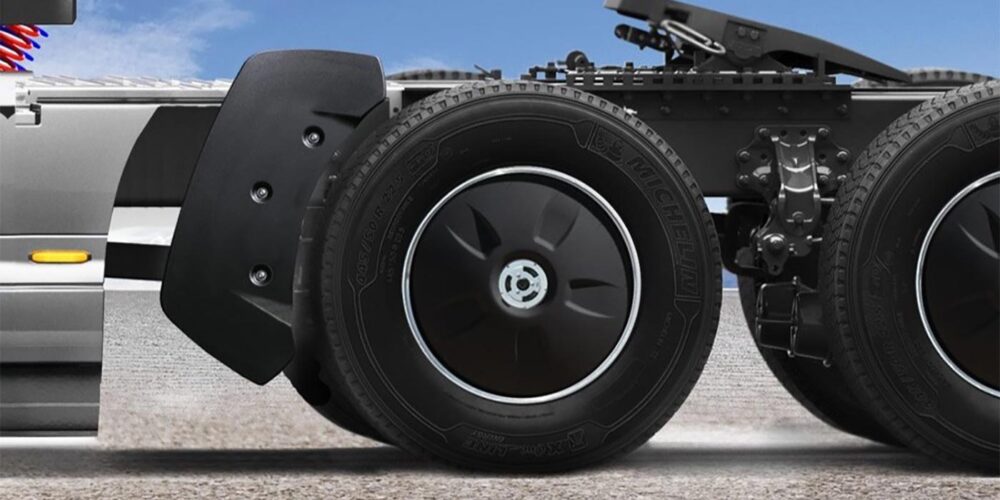“Think of oil analysis as a visit to your engine’s health care professional,” says Edward Covington, vice president, quality assurance at WIX Filters. “Oil analysis provides fact-based information on the oil’s condition, which can then be used to determine the engine’s condition. The data will help answer questions such as is the oil and filter change interval appropriate, is there coolant, fuel, water or dirt in the oil, and is the oil viscosity within appropriate limits?”
Most independent oil analysis laboratories have standard test programs and provide reports with the actual test data values, Covington notes. “Data points of concern are flagged and an overall assessment is given, and special tests can also be requested as needed,” he adds. “A one-time report is good, but routine oil analysis over time can help establish an appropriate oil and filter change interval.
“As the engine wears or the duty cycle changes substantially, the effective drain interval may change,” Covington continues. “The oil quality, duty cycle, fuel type and filter selection all play a large role in establishing an effective oil and filter drain interval so an analysis program can lead to longer engine life and maintaining engine performance.”
Examples
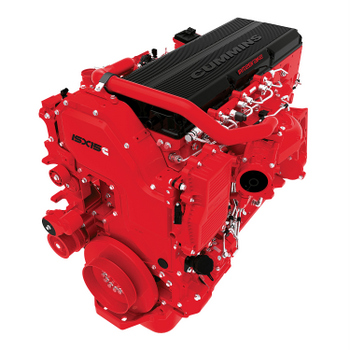 Covington offers specific examples of oil analysis test values and how to interpret results. For instance, Total Base Number (TBN), a standard test and Total Acid Number (TAN), a special test, are indications of how the oil is handling acid build-up from combustion byproducts, heat and moisture. Corrosive wear is more likely to occur when the TBN drops below acceptable limits or TAN rises above certain limits.
Covington offers specific examples of oil analysis test values and how to interpret results. For instance, Total Base Number (TBN), a standard test and Total Acid Number (TAN), a special test, are indications of how the oil is handling acid build-up from combustion byproducts, heat and moisture. Corrosive wear is more likely to occur when the TBN drops below acceptable limits or TAN rises above certain limits.
“Using TBN is one method for determining the end of the useful life of engine oil,” Covington says. “Most engine manufacturers will define acceptable TBN limits, and when this value is reached, the oil and filter should be changed. Generally, the most conservative approach is when the TBN value equals TAN. Another approach is when the original TBN value of the oil drops by a certain number and the least conservative approach is to use a lower limit not to fall below a certain TBN value.
“Also look for signs of excessive mechanical wear indicated by wear metals such as tin, lead, bronze, aluminum and copper for bearings, iron, chromium or titanium for cylinder wall linings and piston rings, and for acceptable oil viscosity,” Covington advises. “Oil viscosity above acceptable limits can lead to premature plugging of oil filters due to oil break down. If the viscosity is very low, it may indicate improperly functioning injectors. In addition, when certain elements or additives are higher than normal, such as potassium or sodium, it may indicate a coolant leak. A high silicon value can indicate a concern with the air cleaner system, such as a leaking clean side duct or an improperly sealed or incorrectly closed housing.”
Trends
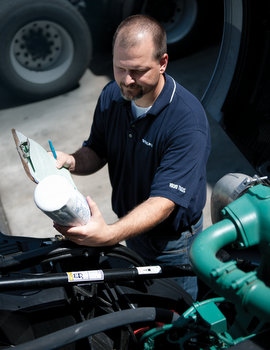 For fleets using oil analysis, technical information from Cummins notes that oil sample collection intervals “must be set in such a manner that trend comparisons can be made” and that “background data is required if oil analysis is to be utilized correctly.” Data, the engine maker relates, must include engine model and serial number, miles and hours of oil use, miles and hours on the engine (new or rebuilt), oil brand, performance category and viscosity grade, the amount of new oil added since the previous oil change, and any recent engine maintenance.
For fleets using oil analysis, technical information from Cummins notes that oil sample collection intervals “must be set in such a manner that trend comparisons can be made” and that “background data is required if oil analysis is to be utilized correctly.” Data, the engine maker relates, must include engine model and serial number, miles and hours of oil use, miles and hours on the engine (new or rebuilt), oil brand, performance category and viscosity grade, the amount of new oil added since the previous oil change, and any recent engine maintenance.
“It is important to conduct oil analysis on new [unused] oil to establish a baseline,” Cummins technical documents state. “Samples should be taken twice a year or each time the oil type is changed at a minimum. Samples should be taken from the bulk supply tanks to determine the makeup of the oil and also to confirm that no contaminants are being introduced by the storage system.”
Used oil analysis, Cummins notes, can monitor engine oil contaminant levels and provide evidence of dirt ingress, excessive fuel contamination (dilution), coolant leaks, excessive soot accumulation and abnormal wear. For example, elevated levels of silicon in the used oil indicate dirt contamination usually caused by faulty intake filtration. The used oil can also contain abnormal levels of copper and lead from bearing material wear, even without extremely elevated levels of chromium and iron being present.
Coolant contamination is identified by abnormal levels of the corrosion inhibitor in the coolant that is leaking into the oil. This results in elevated levels of sodium, potassium, boron and silicon in the used oil. Sodium and potassium content will depend on which is used for a corrosion inhibitor. Additionally, glycol components from antifreeze can be present in the oil.
Guidelines
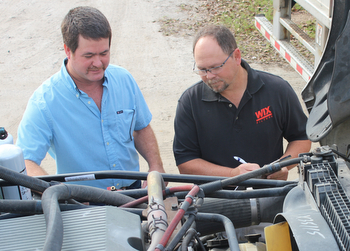 Volvo Trucks offers guidelines for fleets that cover oil analysis methods and requirements for a series of wear element tests, a list of contaminants such as water, fuel and soot, and oil condition indicators including viscosity, TBN, oxidation and nitration.
Volvo Trucks offers guidelines for fleets that cover oil analysis methods and requirements for a series of wear element tests, a list of contaminants such as water, fuel and soot, and oil condition indicators including viscosity, TBN, oxidation and nitration.
Mack Trucks also offers technical advice about oil analysis. “A small sample of the oil should be routinely analyzed to monitor overall conditions,” the company notes. “Engine oil analysis is an important diagnostic and preventive maintenance tool, which is useful for maintaining performance and ensuring durability.”
Monitoring lube oil condition through Mack’s MaxiGard/2 oil analysis program can provide insight into wear rates, lubricant conditions and the presence of harmful contaminants. The MaxiGard/2 analysis consists of a series of laboratory tests on oil samples for wear metals, silica (dirt, dust, sand), coolant, fuel dilution, soot, water, viscosity and TBN. Reports include a description of any abnormal properties, including possible causes, and recommended diagnostic or corrective actions that should be taken.
Benefits
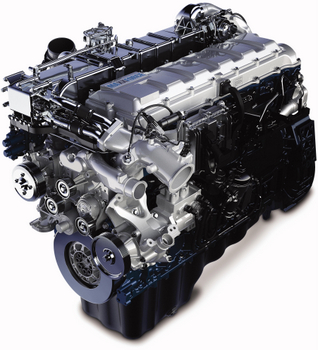 There are a number of benefits for fleets that employ oil analysis programs, including the ability to help reduce maintenance costs by establishing proper drain intervals. In addition, oil analysis can be used to find problems before they cause engine failure.
There are a number of benefits for fleets that employ oil analysis programs, including the ability to help reduce maintenance costs by establishing proper drain intervals. In addition, oil analysis can be used to find problems before they cause engine failure.
“We find fleets use drain intervals as an opportunity to obtain oil samples,” says Heather DeBaun, technical specialist, fluids at Navistar. “Oil analysis is a tool that can be used to confirm the proper oil drain interval is being used as well as look for contamination, especially as trends over time are reviewed. Used oil analysis is a sure way to assess an engine’s health and maximize its life.”






